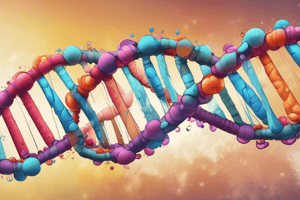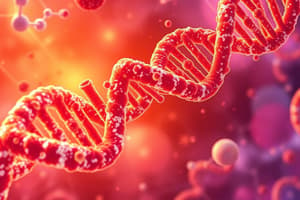Podcast
Questions and Answers
What is the primary function of DNA polymerase I?
What is the primary function of DNA polymerase I?
- To remove RNA phosphodiester bonds and replace them with DNA nucleotides. (correct)
- To synthesize RNA primers for DNA replication.
- To proofread DNA strands from 5' to 3'.
- To synthesize DNA continuously without interruptions.
Which statement accurately describes the lagging strand in DNA replication?
Which statement accurately describes the lagging strand in DNA replication?
- It is synthesized in the 5' to 3' direction without any interruptions.
- It consists of shorter fragments called Okazaki fragments. (correct)
- It is synthesized continuously towards the replication fork.
- It is produced in long, continuous segments as the DNA unzips.
How do pseudonucleotides affect DNA replication?
How do pseudonucleotides affect DNA replication?
- They serve as primers for new DNA synthesis.
- They disrupt the replication process by halting further elongation of the DNA chain. (correct)
- They are recognized and utilized by DNA polymerases to increase efficiency.
- They enhance the elongation of the DNA chain significantly.
What role does the enzyme Primase play in DNA replication?
What role does the enzyme Primase play in DNA replication?
What distinguishes the leading strand from the lagging strand during DNA replication?
What distinguishes the leading strand from the lagging strand during DNA replication?
Which enzyme is primarily responsible for stitching together Okazaki fragments?
Which enzyme is primarily responsible for stitching together Okazaki fragments?
In which direction does DNA polymerase proofread the new strand?
In which direction does DNA polymerase proofread the new strand?
What happens when DNA polymerase I encounters a pseudonucleotide during DNA synthesis?
What happens when DNA polymerase I encounters a pseudonucleotide during DNA synthesis?
What is the primary role of DNA-A protein in the DNA replication process?
What is the primary role of DNA-A protein in the DNA replication process?
Which of the following statements about Okazaki fragments is true?
Which of the following statements about Okazaki fragments is true?
What is the primary challenge that DNA polymerase I addresses?
What is the primary challenge that DNA polymerase I addresses?
How does Topoizomerase resolve the supercoils created during DNA replication?
How does Topoizomerase resolve the supercoils created during DNA replication?
What unique feature does Topoizomerase 2 exhibit compared to other types of Topoizomerases?
What unique feature does Topoizomerase 2 exhibit compared to other types of Topoizomerases?
What is the consequence of antibiotics like Quinolones on bacterial DNA?
What is the consequence of antibiotics like Quinolones on bacterial DNA?
What does the enzyme Primase accomplish during DNA replication?
What does the enzyme Primase accomplish during DNA replication?
In what direction does DNA polymerase synthesize the new DNA strand during replication?
In what direction does DNA polymerase synthesize the new DNA strand during replication?
What initiates the formation of a replication bubble in DNA?
What initiates the formation of a replication bubble in DNA?
Why is the presence of SSB proteins critical during DNA replication?
Why is the presence of SSB proteins critical during DNA replication?
Which feature distinguishes Helicase in the DNA replication process?
Which feature distinguishes Helicase in the DNA replication process?
What role does Etoposide serve in cancer treatment?
What role does Etoposide serve in cancer treatment?
Flashcards
Proofreading by DNA polymerase III
Proofreading by DNA polymerase III
DNA polymerase III uses its 3' to 5' exonuclease domain to cut out the last nucleotide if it was mistakenly added and then replaces it with the correct one
Leading Strand
Leading Strand
The new DNA strand synthesized continuously in the direction of the replication fork.
Lagging Strand
Lagging Strand
The new DNA strand synthesized discontinuously in fragments, going away from the replication fork.
Primosome
Primosome
Signup and view all the flashcards
Okazaki Fragments
Okazaki Fragments
Signup and view all the flashcards
DNA Polymerase I
DNA Polymerase I
Signup and view all the flashcards
Pseudonucleotides
Pseudonucleotides
Signup and view all the flashcards
DNA Ligase
DNA Ligase
Signup and view all the flashcards
5' to 3' Direction of DNA Synthesis
5' to 3' Direction of DNA Synthesis
Signup and view all the flashcards
Origin of Replication
Origin of Replication
Signup and view all the flashcards
Single-Strand Binding Proteins (SSB Proteins)
Single-Strand Binding Proteins (SSB Proteins)
Signup and view all the flashcards
Helicase
Helicase
Signup and view all the flashcards
Supercoils
Supercoils
Signup and view all the flashcards
Topoisomerase
Topoisomerase
Signup and view all the flashcards
Primase
Primase
Signup and view all the flashcards
Primer
Primer
Signup and view all the flashcards
3' to 5' direction
3' to 5' direction
Signup and view all the flashcards
5' to 3' direction
5' to 3' direction
Signup and view all the flashcards
Study Notes
DNA Replication
- DNA replication starts with separating DNA strands at specific locations (origin points/consensus areas). These locations are rich in adenine (A) and thymine (T) base pairs.
- Bacterial DNA has one origin point, while eukaryotic DNA has multiple.
- DNA helicase initially separates the DNA strands, creating a replication bubble.
- Single-strand binding proteins (SSBs) prevent the separated strands from reannealing.
- DNA helicase requires a lot of energy to break hydrogen bonds.
- Topoisomerase enzymes relieve the stress created by unwinding the DNA ahead of the replication fork. There are various types such as Topoisomerase I and Topoisomerase II.
- Some antibiotics like quinolones target bacterial topoisomerases, leading to DNA damage and cell death.
Initiation of Replication
- Primase (a DNA-dependent RNA polymerase) creates short RNA primers which provide a 3' hydroxyl group that DNA polymerase requires to start replication.
- DNA polymerase adds nucleotides to the 3' end of the primer, extending the DNA strand in the 5' to 3' direction.
- Lagging strand synthesis occurs in short fragments (Okazaki fragments) that are later joined by DNA ligase.
DNA Polymerases (Eukaryotic)
- There are multiple DNA polymerases in eukaryotic cells, each with specialized functions.
- Examples include: X-pol (primer), B-pol (repair), and Y-pol (mitochondrial DNA).
- δ-pol elongates the leading strand and ε-pol is also involved in DNA repair.
- Some medications target the mitotic spindle to stop cancer cell replication. Examples include vinblastine and vincristine. Others, like Paclitaxel and Docetaxel, hyperstabilize the spindle.
Anti-cancer and Anti-viral Drugs
- Anti-cancer and anti-viral drugs include analogs of nucleotide bases or altered sugar structures in nucleotides. Examples are didanosine, vidarabine, acyclovir, cytarabine, and zidovudine.
- These altered nucleotides can interfere with DNA polymerase function, causing replication errors and preventing cell growth and replication.
Studying That Suits You
Use AI to generate personalized quizzes and flashcards to suit your learning preferences.




